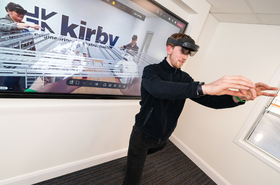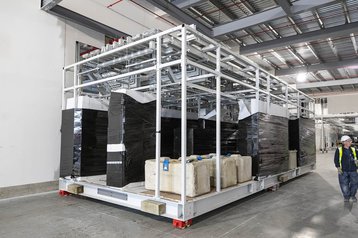When the British nuclear submarine HMS Vanguard (cost: £3.75bn/$4.65bn) was undergoing routine maintenance, an engineer working in the nuclear reactor chamber accidentally over-tightened one of the bolts, leading it to sheer off.
Disaster. The only fix would have been to laboriously drill out the bolt, tidy the screw thread and fix a new bolt, properly.
That, however, was too much like hard work for the engineers working on it, who decided to superglue the bolt-head back on and hope that no-one would notice, covering their backsides by filing a mundane ‘process of work issue’ form that omitted the critical details. Unfortunately for the lackadaisical engineers, the glued-on bolt-head fell off and the cunning plan was exposed.
Not surprisingly, when the news leaked the Ministry of Defence went ballistic. After all, few complex projects of any type go 100 percent according to plan, and no-one wants to be taken by surprise by ‘issues’ emerging that they ought simply have been informed about, then dealt with.
At the moment, there aren’t any nuclear-powered data centers to which such an issue might apply, but building or upgrading a data center facility always presents its challenges. However, overcoming such challenges and providing clients with a “no surprises approach” is a key element of ‘The Kirby Way’ and its unique project processes, says Ronan O'Neill, Kirby’s Associate Director – Planning and Project Risk.
Kirby Group Engineering provides full mechanical and electrical contracting services as well as specialist high voltage (HV) and medium voltage (MV) design and construction services to clients across a number of different sectors including Data Centres. Hence, there isn’t much that the project professionals at Kirby don’t know about kitting out a data center.
O’Neill explains how Kirby is setup to deliver its projects: “Each operational support department is required to deliver upon three core elements: service, consultancy and governance.
“Our long-term clients know what to expect from us - a predictable, solution-based approach that delivers repeatable results, no matter the region. Kirby has developed detailed standard operating procedures (SOPs) and processes to ensure consistency of approach, while promoting how it wants to do business – a ‘no surprises approach’ – and being open and honest with both our clients and supply chain.
“These SOPs highlight the company’s collaborative approach, both internally and with external stakeholders, and how project risk is identified, assessed, communicated, and escalated. Depending on the nature and severity of the risk event, no matter the project or region, within 30 minutes the managing director will be informed,” says O’Neill.
He continues: “Escalation and intervention within Kirby happens rapidly. Despite our growth and the scale of business, we have a hands-on senior management team, we aren’t afraid to roll-up the sleeves, and actively get involved with project and client teams in any issue resolution.”
Of course, project management is a well understood discipline taught in business schools all over the world. But it is quite another to learn from the shortcomings of one project and apply them to the next in a bid to get better and better.
That is the essence of “The Kirby Way”, says O’Neill.
“The Kirby Way, is our approach to project delivery. It is a set of processes that ensures consistent, positive outcomes on our projects and trains our teams to promote the ethos of the ‘no-surprises approach’, going the extra mile, and adding value to our customers.”
These processes, he adds, have been designed not just to ensure successful project delivery. These processes also encapsulate the company’s five core values: People first, says O’Neill, followed by safety, quality, delivery, and value.
First principles
Underpinning Kirby’s ‘no surprises’ approach to project delivery is information – lots of it.
Partly, this has been gleaned via decades of experience in project management, in both the data center sector and other high-tech areas. But also, by taking a thorough approach at the pre-construction phase, bringing together stakeholders and rigorously planning out the project.
This maximizes the prospect of a predictable and, hence, successful outcome to any project.
“Our planning process is based on collaboration. We like to work in an engaged way, sharing information with all the other stakeholders because, too often, people work in isolation, in a siloed manner.
When that happens, it causes uncertainty and leads to problems because everyone then lacks the all-round visibility that they need to run a project with confidence,” says O’Neill.
Moreover, this approach to planning permeates the project right through from pre-construction to commissioning, because from experience, the company is well aware that the sharp end of data center delivery is the commissioning stage.
“The earlier we can engage with clients, design teams, commissioning agents and any other stakeholder who has a vested interest in the project, the better we can influence the successful outcome of the project.
“By prioritizing and influencing design to facilitate the coordination for off-site manufacturing, you need to prioritize certain elements of design. That includes sizing of equipment, ensuring that the steel is designed in a certain way in the building to move in the prefabricated modules. Further to this is determining and understanding, early on in that whole process, the true effort required to deliver each project milestone, so that we can effectively plan and control the entire project delivery process.
“After all, we want to ensure that we don’t make commitments without understanding the full extent of project requirements. Building the full picture of what the success looks like for our clients, and what ‘the ask’ is, is essential – especially if ‘the ask’ might not be achievable,” says O’Neill.
“If we do find that, after assessing all the information, the optimum way of doing something is not what is presented in front of us, we’ll take that back to the customer and work through it with them.”
All that pre-construction prep’ is, therefore, all about setting up the conditions for success throughout the project, which is why Kirby goes into so much detail and depth at the outset, while keeping the client and other stakeholders fully engaged in this process.
Of course, even the best of plans rarely ‘survive first contact with the enemy’, as the old military saying goes, which is why The Kirby Way also involves keeping a close eye on the metrics that matter and having an acute awareness and appreciation of the status and performance of a project – in as close to real time as possible.
“We know that things change almost as soon as the plan is developed, and as soon as the plan is developed, you're at risk of it falling behind.
“That's why we make sure that everyone is bought into the plan in a collaborative manner; everyone knows their roles and responsibilities. There's clear communication from ‘the coalface’ back to the management team, the client and into the business.
“We empower our project managers with fact-based information so that they can make objective, risk- and fact-based decisions for the good of the project,” says O’Neill. “Indeed, we’re always looking for ways to become more efficient in what we do by linking technologies, eliminating double handling of information, and having a single source of the truth”.
“We use various technologies, data visualization and analytics software and continue to invest in, and evolve in terms of digitizing our project delivery. We are not there yet, but we are making significant progress. We need to communicate the right information from our process outputs simply, and in as close to real time as possible,” he adds.
Underpinning all this is ongoing ‘outcome forecasting’ that enables Kirby’s project teams to stay on top of the projects they’re working on. For Kirby it’s about leading indicators, identifying trends and forecasting possible outcomes. This enables its staff to engage in data center projects to anticipate, predict and mitigate against “risk events” and to maintain tight control their projects.
After all, whether its nuclear submarine maintenance or data center build-outs, complex projects always need to be planned and executed in the right way to ensure that there are no unpleasant surprises at any time, let alone when they’re least expected.
To find out more about Kirby’s approach to delivering electrical and mechanical projects ‘The Kirby Way’, go to www.kirbygroup.com
More...
-

Sponsored Data center developments: The people behind the projects
Why an investment in people is imperative to delivering data center developments on demand
-

Looking at construction through technology
Kirby tells us about the new technologies they use to improve construction
-
![Kirby preferred image_DSB02044[145153].jpg](https://media.datacenterdynamics.com/media/images/Kirby_preferred_image_DSB020441451.2e16d0ba.fill-280x185.jpg)
Sponsored Data center supply chain challenges: It’s good to talk
Managing complex supply chains today requires diligence and hard work to bring data center builds in successfully and on-budget, advises Kirby procurement specialist David Waldron



